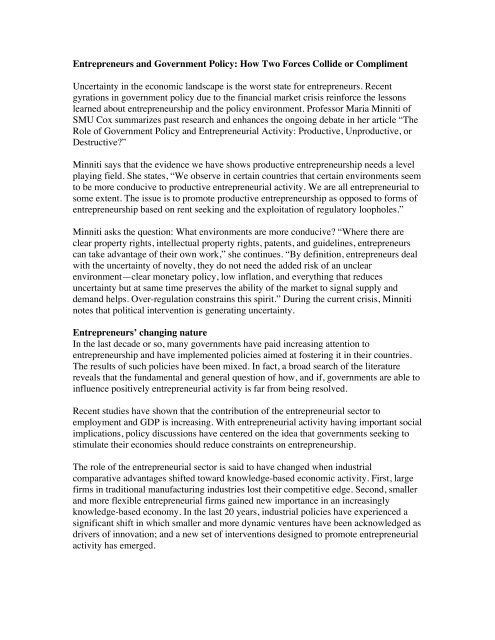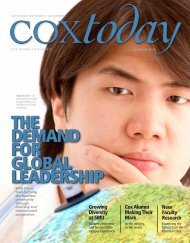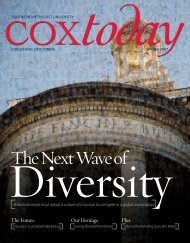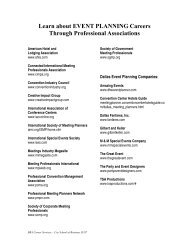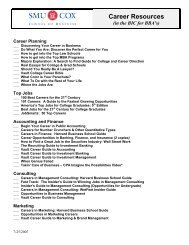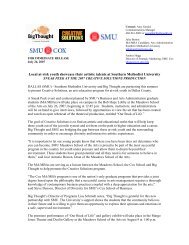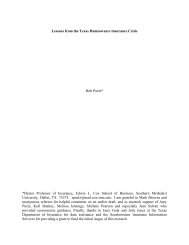Entrepreneurs and Government Policy: How Two Forces Collide or ...
Entrepreneurs and Government Policy: How Two Forces Collide or ...
Entrepreneurs and Government Policy: How Two Forces Collide or ...
Create successful ePaper yourself
Turn your PDF publications into a flip-book with our unique Google optimized e-Paper software.
<strong>Entrepreneurs</strong> <strong>and</strong> <strong>Government</strong> <strong>Policy</strong>: <strong>How</strong> <strong>Two</strong> <strong>F<strong>or</strong>ces</strong> <strong>Collide</strong> <strong>or</strong> Compliment<br />
Uncertainty in the economic l<strong>and</strong>scape is the w<strong>or</strong>st state f<strong>or</strong> entrepreneurs. Recent<br />
gyrations in government policy due to the financial market crisis reinf<strong>or</strong>ce the lessons<br />
learned about entrepreneurship <strong>and</strong> the policy environment. Profess<strong>or</strong> Maria Minniti of<br />
SMU Cox summarizes past research <strong>and</strong> enhances the ongoing debate in her article “The<br />
Role of <strong>Government</strong> <strong>Policy</strong> <strong>and</strong> Entrepreneurial Activity: Productive, Unproductive, <strong>or</strong><br />
Destructive?”<br />
Minniti says that the evidence we have shows productive entrepreneurship needs a level<br />
playing field. She states, “We observe in certain countries that certain environments seem<br />
to be m<strong>or</strong>e conducive to productive entrepreneurial activity. We are all entrepreneurial to<br />
some extent. The issue is to promote productive entrepreneurship as opposed to f<strong>or</strong>ms of<br />
entrepreneurship based on rent seeking <strong>and</strong> the exploitation of regulat<strong>or</strong>y loopholes.”<br />
Minniti asks the question: What environments are m<strong>or</strong>e conducive? “Where there are<br />
clear property rights, intellectual property rights, patents, <strong>and</strong> guidelines, entrepreneurs<br />
can take advantage of their own w<strong>or</strong>k,” she continues. “By definition, entrepreneurs deal<br />
with the uncertainty of novelty, they do not need the added risk of an unclear<br />
environment—clear monetary policy, low inflation, <strong>and</strong> everything that reduces<br />
uncertainty but at same time preserves the ability of the market to signal supply <strong>and</strong><br />
dem<strong>and</strong> helps. Over-regulation constrains this spirit.” During the current crisis, Minniti<br />
notes that political intervention is generating uncertainty.<br />
<strong>Entrepreneurs</strong>’ changing nature<br />
In the last decade <strong>or</strong> so, many governments have paid increasing attention to<br />
entrepreneurship <strong>and</strong> have implemented policies aimed at fostering it in their countries.<br />
The results of such policies have been mixed. In fact, a broad search of the literature<br />
reveals that the fundamental <strong>and</strong> general question of how, <strong>and</strong> if, governments are able to<br />
influence positively entrepreneurial activity is far from being resolved.<br />
Recent studies have shown that the contribution of the entrepreneurial sect<strong>or</strong> to<br />
employment <strong>and</strong> GDP is increasing. With entrepreneurial activity having imp<strong>or</strong>tant social<br />
implications, policy discussions have centered on the idea that governments seeking to<br />
stimulate their economies should reduce constraints on entrepreneurship.<br />
The role of the entrepreneurial sect<strong>or</strong> is said to have changed when industrial<br />
comparative advantages shifted toward knowledge-based economic activity. First, large<br />
firms in traditional manufacturing industries lost their competitive edge. Second, smaller<br />
<strong>and</strong> m<strong>or</strong>e flexible entrepreneurial firms gained new imp<strong>or</strong>tance in an increasingly<br />
knowledge-based economy. In the last 20 years, industrial policies have experienced a<br />
significant shift in which smaller <strong>and</strong> m<strong>or</strong>e dynamic ventures have been acknowledged as<br />
drivers of innovation; <strong>and</strong> a new set of interventions designed to promote entrepreneurial<br />
activity has emerged.
The power to influence<br />
In his classic 1990 research, Baumol argued that the supply of entrepreneurs <strong>and</strong> the<br />
nature of their motives undergo no significant change from one period to another: What<br />
matters, instead, are institutions—the rules of the game dictating the ultimate effect of<br />
entrepreneurship on the economy via the allocation of entrepreneurial resources. The<br />
contribution of entrepreneurial activity varies because of its allocations between desirable<br />
activities, such as innovation, <strong>and</strong> unproductive activities, such as rent seeking <strong>or</strong><br />
<strong>or</strong>ganized crime. Thus, with the appropriate institutions, government policy can influence<br />
the allocation of entrepreneurship m<strong>or</strong>e effectively than its supply.<br />
Institutions, such as the policy environment, influence the relative incentives <strong>and</strong> payoffs.<br />
Thus government policy has the power to influence entrepreneurial activity, but may not<br />
be necessarily desirable, as it may steer entrepreneurs toward actions that have negative<br />
socioeconomic consequences.<br />
<strong>Policy</strong> strategies, with respect to entrepreneurship, need to be tail<strong>or</strong>ed to the specific<br />
institutional context of each economic region—“one size does not fit all.” F<strong>or</strong> example,<br />
the environments required f<strong>or</strong> productive entrepreneurship are likely to differ<br />
significantly between a rural area, a high-technology cluster <strong>and</strong> a metropolitan area.<br />
Theref<strong>or</strong>e, policy design needs to take account of local differences, <strong>and</strong> to adapt to the<br />
different scale <strong>and</strong> nature of existing resources, netw<strong>or</strong>ks, <strong>and</strong> market capabilities. In<br />
spite of this need f<strong>or</strong> diversity, entrepreneurship policies tend to be based on a h<strong>and</strong>ful of<br />
policy tools. Among them are financing, taxation, regulations on trade, <strong>and</strong><br />
encouragement of innovation activities.<br />
The empirical evidence on the effectiveness of financing supp<strong>or</strong>t is mixed. While<br />
microfinance schemes are usually assessed positively, other f<strong>or</strong>ms of financing have been<br />
criticized. Some governments have also focused their eff<strong>or</strong>ts toward attracting new<br />
venture capital. The empirical evidence, however, is once again mixed. Research has<br />
shown that entrepreneurial activity attracts new venture funding, but the reverse is not<br />
true. Additionally, venture capital has been shown to account f<strong>or</strong> only a very small<br />
amount of overall financing to entrepreneurship.<br />
The policy instrument of taxation is shown to be less imp<strong>or</strong>tant to entrepreneurs than is<br />
often p<strong>or</strong>trayed. Minniti says, “Of course entrepreneurs want lower taxes, but it’s m<strong>or</strong>e<br />
imp<strong>or</strong>tant to have a fav<strong>or</strong>able environment where one can make reasonable guesses about<br />
the future.”<br />
Barriers to trade are particularly costly <strong>and</strong> detrimental to the entrepreneurial sect<strong>or</strong>.<br />
While internationalization (globalization) has been described as a gradual, sequential<br />
process, m<strong>or</strong>e recent research has shown that firms do not necessarily follow any<br />
consistent pattern in their internationalization. In fact, start-ups emerging in knowledgebased<br />
industries are likely to enter international markets directly <strong>and</strong>, as a result, are m<strong>or</strong>e<br />
likely to benefit from low trade barriers.
Supp<strong>or</strong>ting innovation<br />
Though globalization extends the frontier f<strong>or</strong> entrepreneurs, another common type of<br />
policy has focused on local interventions. The best known example of such policies are<br />
the creation of f<strong>or</strong>mal <strong>and</strong> inf<strong>or</strong>mal supp<strong>or</strong>t mechanisms (f<strong>or</strong> example, chambers of<br />
commerce <strong>and</strong> training programs), publicly spons<strong>or</strong>ed incubat<strong>or</strong>s, <strong>and</strong>, most of all,<br />
science, technology, <strong>and</strong> research parks. Entry, growth, survival, <strong>and</strong> the way firms <strong>and</strong><br />
industries change over time are linked to innovation. Thus, the perf<strong>or</strong>mances of regions<br />
<strong>and</strong> even entire economies have been linked to how well the potential from innovation is<br />
expressed in the economy. Rather than imp<strong>or</strong>ting successful policies from other areas,<br />
direct subsidies f<strong>or</strong> R&D <strong>and</strong> supp<strong>or</strong>t of linkages between universities <strong>and</strong> the private<br />
sect<strong>or</strong> should reflect <strong>and</strong> respond to the needs of specific localities <strong>or</strong> regions to be<br />
effective.<br />
Local entrepreneurial policies are still evolving, but are clearly gaining in imp<strong>or</strong>tance <strong>and</strong><br />
impact in the p<strong>or</strong>tfolio of policy instruments. In roughly the last 20 years, governments<br />
have become increasingly active in assisting entrepreneurs at the regional level <strong>and</strong><br />
fostering industrial clusters, technology transfer, <strong>and</strong> high-tech start-ups under the<br />
assumptions that these sect<strong>or</strong>s will be competitive in the future. Researchers provided<br />
considerable evidence that knowledge spillovers result in both a geographic clustering of<br />
innovative activity, as well as an increase in start-ups across innovative industries, such<br />
as semiconduct<strong>or</strong>s <strong>and</strong> biotechnology.<br />
Knowledge is inherently different from traditional fact<strong>or</strong>s of production, such as l<strong>and</strong>,<br />
lab<strong>or</strong> <strong>and</strong> capital, <strong>and</strong> is m<strong>or</strong>e difficult to evaluate. While the contribution of innovation<br />
policy to entrepreneurship has become a mantra f<strong>or</strong> today’s policy makers, the<br />
implementation <strong>and</strong> assessment of policy remains problematic because many of these<br />
initiatives are still too young to be assessed.<br />
Research found that states with both economic <strong>and</strong> science <strong>and</strong> technology (S&T)<br />
initiatives have six times as many new firms than states without such initiatives. But<br />
economic initiatives have a stronger effect than S&T initiatives. States with the earliest<br />
innovation policies, as evidenced by first-mover advantages, also have higher rates of<br />
related firm founding over time. States that are most attractive to entrepreneurs pursue<br />
technological innovation but also encourage <strong>and</strong> legitimize commercial development.<br />
What matters, researchers say, is not the type of industries that develop, but the<br />
environment in which entrepreneurship takes place. A good regional context f<strong>or</strong><br />
innovation might resemble a diversified city made up of many specialized clusters—the<br />
birth, life, <strong>and</strong> death of diversified urban centers being part of a spontaneous <strong>or</strong>der that<br />
rests on entrepreneurship.<br />
Minniti comments on the case of New Y<strong>or</strong>k City. “Crime used to be the main problem.<br />
This applies also to some areas of Dallas.” She speaks of how New Y<strong>or</strong>k is now<br />
completely different than it was 20 years ago. The main thing, she relays, was cleaning<br />
up the streets. Crime is the single most imp<strong>or</strong>tant fact<strong>or</strong> because people are then afraid to<br />
w<strong>or</strong>k, live, <strong>and</strong> do business with its associated costs. She adds, “Resources are scarce so a
city cannot do all of the proposed initiatives at the same time. Giuliani did this type of<br />
concentrated intervention to reduce crime. You cannot address everything at same time.”<br />
There was a big payoff f<strong>or</strong> New Y<strong>or</strong>k in focusing their resources. She mentions that once<br />
the crime was gone, businesses returned <strong>and</strong> dilapidated streets were beautified. “People<br />
respond to incentives, not necessarily monetary ones. A similar process seems to be<br />
happening in Newark, NJ.”<br />
<strong>Government</strong>s are not able to make any prediction about what type of entrepreneurial<br />
activity is m<strong>or</strong>e desirable, n<strong>or</strong> about how to make it emerge; to do so would require them<br />
to perf<strong>or</strong>m an impossible calculation. But governments can create a reliable set of<br />
institutions in which the entrepreneurial spirit of people may flourish. Policies that ensure<br />
institutional transparency, predictable taxation, <strong>and</strong> secure property rights do not require<br />
computations of specific outcomes.<br />
Conclusion<br />
Effective entrepreneurship policy cannot be one that limits itself to business subsidies <strong>or</strong><br />
imposes top-down strategies. The fact that entrepreneurship is positively linked to<br />
perf<strong>or</strong>mance does not justify public policy intervention. The m<strong>and</strong>ate f<strong>or</strong> public policy<br />
intervention can only be the result of fundamental market failures. <strong>Entrepreneurs</strong>hip is<br />
there, whether we like it <strong>or</strong> not. <strong>Government</strong>s can only provide an environment<br />
conducive to productive rather than unproductive entrepreneurship. Thus, government<br />
should create enabling environments conducive to the division of lab<strong>or</strong>, the<br />
commercialization of invention, <strong>and</strong> exchange. Too much public involvement can hinder<br />
entrepreneurs by creating possible market dist<strong>or</strong>tions.<br />
In the end, government policy should not aspire to the elimination of new venture<br />
failures. Although painful at the microeconomic level, business churning is part of a<br />
healthy economic system. Most imp<strong>or</strong>tant, only the market can determine what the<br />
optimal amount of entrepreneurship is — <strong>and</strong> which firms to target f<strong>or</strong> success <strong>or</strong> failure.<br />
In this current business climate, Minniti elab<strong>or</strong>ates on the idea of allowing business to<br />
reconcile their mistakes: “My impression is that small business will fare better because<br />
they are m<strong>or</strong>e flexible, nimble, <strong>and</strong> can adjust better. The main crisis we’re seeing is of<br />
very large companies. They would have probably been in difficulties regardless of the<br />
situation because of their structural <strong>and</strong> competitiveness issues.” She continues, “At the<br />
micro-level, there is a cost when there is a downturn in the business cycle. But at the<br />
economy level, subsidizing failure too long may cause a long-term effect. F<strong>or</strong> example, if<br />
we transfer bad debt <strong>and</strong> make it good because of a government guarantee, I don’t see<br />
any incentive f<strong>or</strong> people in the market to start responding again to what the economy<br />
requires.” She adds that given the size of the deficit, “ I don’t see how we cannot have<br />
inflation. There is a strong risk of making things w<strong>or</strong>se.”<br />
The recent financial crisis provides a real-time textbook example of the effects of<br />
government policy interventions <strong>and</strong> its role in entrepreneurship.
“The Role of <strong>Government</strong> <strong>Policy</strong> <strong>and</strong> Entrepreneurial Activity: Productive,<br />
Unproductive, <strong>or</strong> Destructive?” by SMU Cox Chair of <strong>Entrepreneurs</strong>hip Maria Minniti<br />
was published a special issue of <strong>Entrepreneurs</strong>hip The<strong>or</strong>y <strong>and</strong> Practice (September<br />
2008).<br />
Summary by Jennifer Warren.


